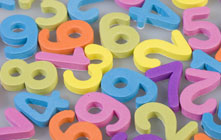4th Grade Decimals: Math Help and Problems
In 4th grade, students learn about decimal numbers, which builds on what they learned in 3rd grade about fractions. As a result, you can use many of the same techniques at home to teach your child decimals. Keep reading to find out how you can help your child master decimals at home.

Teaching Decimals to 4th Graders
Background
Fractions
Coming into 4th grade, a child should understand that a fraction represents a part of a whole number (i.e., 9/10 is almost 1). Children at this level should also know that two equivalent fractions, such as 1/2 and 2/4, represent the same part of a whole number and have the same value. In addition, 4th graders should also know that whole numbers can be written as fractions (for example, 4/2 is the same as 2). Also, by the 4th grade a child should be able to:
- Find or place basic fractions on a number line divided into equal parts between zero and one (i.e., 1/2 would be a point midway between 0 and 1 on the number line).
- Understand the difference between fractions that have either the same denominator (1/3 and 2/3, for example) or the same numerator (2/4 and 2/5).
Place Values
Your child has been working with the concept of place values in whole numbers since kindergarten. By the time he reaches 4th grade, he should be fluent in naming and finding numbers in place values to the thousands, which includes ones, tens, hundreds and thousands. Children need a strong understanding of place value in order to be successful with decimals. If your child is struggling with place value, you may want to help him make a place value chart before he starts 4th grade.
New Topics
Place Values
After reviewing place values to the thousands, your child will learn that decimal place values are similar to whole number place values except that the names end in 'th' (e.g., tenths, hundredths and thousandths). The place values begin from the decimal point. Whole number place values go from right to left; decimal place values move from left to right. It can be helpful to make a visual chart for future reference in class and at home.
Fractions and Decimals
Introduce decimals as being another way to express a portion (or fraction) of a whole number. Demonstrate that fractions with denominators of ten or 100 can be easily turned into decimals and are read the same way. For example, 1/10 and 0.1 are both read as one tenth; 43/100 and 0.43 are both read as forty-three hundredths.
In 4th grade, your child will be adding fractions with denominators of ten and 100 (among others). When he has added two fractions with these denominators, he will likely be asked to also write the answer in decimal form.
In addition, your child will learn to compare decimals. She will be taught that in order to compare decimals, the decimals must be referring to the same whole. She will learn to record comparisons by using the symbols <, = and > (less than, equal to, and greater than).
Problems
In most cases, students don't learn to add and subtract decimals until 5th grade. As a result, decimal problems in 4th grade generally follow formats such as:
- 1. Write 7/10 as a decimal.
- Answer: 0.7
- 2. Write 7/100 as a decimal.
- Answer: 0.07
- 3. Add 7/10 and 7/100; write the answer first as a fraction and then as a decimal.
- Answer: 7/10 + 7/100 = 70/100 + 7/100 = 77/100 or 0.77
- 4. Which is larger - 9/10 of a pizza or 0.09 of the pizza?
- Answer: 9/10 > 0.09
- 5. Which would you rather have - 3/10 of a dollar, 30¢ or 0.3 of a dollar?
- Answer: It doesn't make any difference because they are all the same.
Other Articles You May Be Interested In
-
Tips to Help Kids Understand Decimals

The decimal numbering system is the basis for modern number theory. Read on to learn how to help your children understand decimal places, percentages, and place values.
-
Tips to Helping your Fifth Grader with Place Value and Decimals in Their Math Homework

Place values and decimal mathematics can be confusing, but the way to master decimals is to first learn how place values work. By learning place values and decimals, your child will be able to better understand the math concepts they will learn in middle and high school.
We Found 7 Tutors You Might Be Interested In
Huntington Learning

- What Huntington Learning offers:
- Online and in-center tutoring
- One on one tutoring
- Every Huntington tutor is certified and trained extensively on the most effective teaching methods
K12

- What K12 offers:
- Online tutoring
- Has a strong and effective partnership with public and private schools
- AdvancED-accredited corporation meeting the highest standards of educational management
Kaplan Kids

- What Kaplan Kids offers:
- Online tutoring
- Customized learning plans
- Real-Time Progress Reports track your child's progress
Kumon

- What Kumon offers:
- In-center tutoring
- Individualized programs for your child
- Helps your child develop the skills and study habits needed to improve their academic performance
Sylvan Learning

- What Sylvan Learning offers:
- Online and in-center tutoring
- Sylvan tutors are certified teachers who provide personalized instruction
- Regular assessment and progress reports
Tutor Doctor

- What Tutor Doctor offers:
- In-Home tutoring
- One on one attention by the tutor
- Develops personlized programs by working with your child's existing homework
TutorVista

- What TutorVista offers:
- Online tutoring
- Student works one-on-one with a professional tutor
- Using the virtual whiteboard workspace to share problems, solutions and explanations